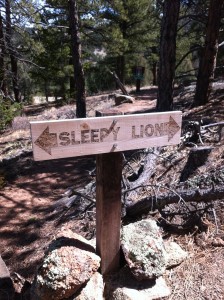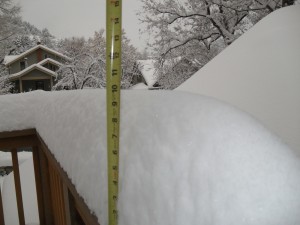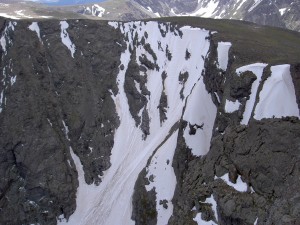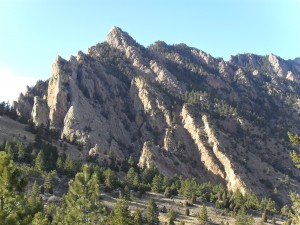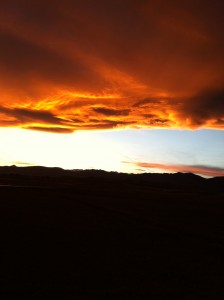Journal

Sheep Creek Avalanche near Loveland Pass, CO (Dale Atkins)
A big avalanche accident happened on April 20 near Loveland Pass. The photo above, made by my friend Dale Atkins, an avalanche expert, shows the results of this humongous slide. Dale discusses avalanche accidents in my book Colorado 14er Disasters. This one was triggered by a group of 6 backcountry skiers and snowboarders, 5 of whom were killed. One survived after being buried for 4 hours, trapped in the cement-like debris with only his face and one arm free. He would have been buried even longer except that some highway workers saw the results of the slide and initiated the events that eventually lead to his rescue.
This was the deadliest avalanche in Colorado in 50 years. But even more notorious, this group was perhaps the most well prepared of any who venture into the backcountry to avoid or at least survive an avalanche. But they failed spectacularly. What happened?
Consider their preparation: They were part of a large organized group who met at the Loveland Ski Area parking lot to promote backcountry avalanche awareness. The group of 6 broke off to do a short downhill run, presumably to check out the snow conditions as well. Here are the facts:
- The group read and discussed the snow conditions report from the Colorado Avalanche Information Center (CAIC). It described a “deep, persistant slab,” meaning that there was a widespread weak layer of snow well below the upper consolidated layers. These weak layers are what make Colorado avalanches so dangerously unpredictable. Unless you know about them by studying the current snowpack and the CAIC reports, they are invisible. This group knew about the layer and decided to head toward what they thought would be a safer slope.
- When they got to the lower end of the Sheep Creek drainage, they spread out 50 feet apart to climb up the snow near the trees. This is exactly what they should have done in terrain that could avalanche, we did this all the time. The idea is that if an avalanche comes down it won’t catch everyone and there will be someone to dig up those who get caught.
- They were all wearing avalanche beacons, radio transceivers that allow you to be found if you are buried. Also, two were wearing avalungs and two were wearing avalanche airbags. The avalung is worn next to the body and helps you breath if buried in snow. The airbags help you ride on top of a slide. These are newer devices that help you survive if caught and are not very common. In other words, these guys were prepared for the worst.
- When the group triggered the avalanche, they were apparently in the runout zone, the relatively flat area below the gully. They heard a whumpf of the weak layer settling which caused a crack to run all the way to the top of the gulley. Minutes later the massive snowslide followed. Of particular note is that they were not on the steep slope but rather the flat area that itself could not avalanche. This is well known to be a danger zone, though the uneducated may feel safe here. Because the group was spread out, they apparently knew the danger.
They did everything “right” yet 5 are dead. As Dale Atkins has said many times, don’t let your equipment and training change affect your decision to go out on a risky slope. If the slope is dangerous, nothing you know or wear will change that. It’s best just to avoid the slope, come back on another day.
———————————————-
Saturday was the first spring-like weekend day around here in a while and the hiking trails around Boulder were overwhelmed by people, far too many for me. I wasn’t into doing any backcountry skiing on such a nice day and the snow line is still pretty low, so I wanted to hike around the foothills where it wouldn’t be muddy but get away from the masses. I hadn’t been down to Green Mountain, which is located on the western edge of Lakewood, for a long time and so decided to visit.
This is where we used to teach map and compass navigation to students in the Colorado Mountain Club mountaineering school. That was many years ago and wow have things changed since then. There are nice, signed and maintained trails all over the mountain, plus several new parking lots. Though there were always trails everywhere, they were rustic with no signage. It’s kind of cool that Jefferson County has taken an active role in managing this park. It’s a large area too, I did a 7.5 mile circuit shown by my GPS track below right.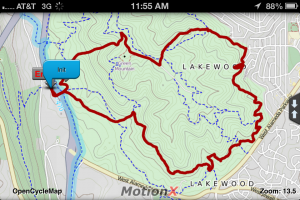
Unfortunately, it is located just east of the 8-lane C-470, a commercial race track and a dirt bike track. These three combine to make it impossible to escape engine noise which is audible in almost every area of Green Mountain. Oh well, not everywhere can be like Boulder open space…:-)
Still, if I lived in the area I would be very grateful for this park. Any green space is good, especially near urban centers. In 2006 I visited Taipei on a business trip, a huge city with a massive population. It took at least an hour to taxi from the airport to my hotel through nothing but buildings, concrete and asphalt. I was pleasantly surprised to find a mountain park near my hotel, a tropical forest-covered hill surrounded by skyscrapers. It was a great escape from the crowds and artificial environment, if only for a little while.
I have to say that a big issue that needs to be dealt with in open space are careless users. It is far too easy for urban parks and open space areas to become trashed out and dangerous places. In my opinion, only active and aggressive management can prevent them from becoming a tragedy of the commons. It only takes a very few bad actors, who will always be around, to begin the trashing cycle. Without money, volunteers and rangers these urban interface parks become undesirable or even unusable.
———————————————-
I was in Oregon last week during the last major snowfall here. It was 70 degrees under cloudless blue skies. It was one of those rare occasions that the weather was better in Portland than it was here. While there I heard several news stories about Dustin Self, the guy who disappeared in the south central Oregon wilderness last month. The stories were about alleged sightings of Dustin around Oregon and that they would not continue to look for him until conditions “improved.” They’re waiting for the snow to melt.
Posted in Journal by Mark with comments disabled.
Missing in the Wilderness

Steens Mountain Wilderness in Oregon, where Dustin Self is presumed missing
Today this story about Dustin Self of Oklahoma City caught my attention. He went missing about a month ago and his abandoned truck was recently found near Steens Mountain, a remote wilderness area in southeast Oregon. Another story is here.
These are the apparent facts: Dustin Self drove from Oklahoma City to Oregon. He was last heard from about a month ago when he made a call to his ex-girlfriend saying that he was lost. His ex called the authorities in Oregon and they did some investigation and find out he was last seen in the small community of Fields, Oregon, where he asked directions to Lakeview, a town about a hundred miles west of Fields. There were no other signs of Self until Monday when his truck was found by a rancher. It was located about 500 feet down a ravine, in the desert on the east side of Steens Mountain, which is about 25 miles north of Fields. Self was not in the truck and there were no reported clues as to where he is. The search was postponed due to high winds in the area yesterday.
The background story is this: An Oklahoma teen tells his parents he is “going off the grid” for a few months and drives to Oregon. He wants to live off the land and investigate a religious group that drinks South American hallucinogenic tea in its ceremonies. He is reportedly a big fan of Into the Wild. He had broken up with his girlfriend the day before he left Oklahoma.
This is another interesting mystery of disappearing in the wilderness. What really happened we don’t know yet but I can’t help but notice the similarities between Self and Winston Branko Churchill, who I wrote about in Forty Demons. Like Winston and Chris McCandless from Into the Wild, Self apparently had a love of the wilderness and was seeking a more intense connection. And like Winston, Self seemed to have an interest in Ayahuasca, the South American hallucinogenic tea mentioned in the articles.
But to be frank, media reports on stories like this are notoriously inaccurate. If you read the two articles I linked to at the beginning of this post, you’ll notice that when they mention Self’s outdoor survival experience, one article spins it to give an impression he is a complete novice while the other one gives the impression that he is well equipped and ready to survive anything. Which is it? Also, he is described as a “teen,” which I guess is technically accurate but in reality he is a 19-year-old man. I and my friends went on many true wilderness adventures at this age and younger.
Also, if Self were trying to drive from Fields to Lakeview, he was way, way off track based on where his truck was found. There are many possibilities for this other than being lost. He may have been intending to disappear, as one report stated. Or he may have had an accident, got stuck and tried to walk out and became lost. Or he may have been the victim of foul play. We don’t know and may never know. Even after Winston’s body was found near a remote cabin in the Uncompahgre Wilderness, it took significant investigation to understand what might have been going on in his head during his last month of life.
Or Dustin Self may walk out and have a great story to tell. Only time can tell.
Posted in 40 Demons Archive, Journal by Mark with comments disabled.
Journal
Sleepy Lion Trail Sign
Ok, last weekend was kind of lazy but I did a couple of short hikes near home. Saturday was beautiful and it seemed all of Boulder was outside in the foothills. I decided to hike up to the Third Flatiron. One great thing about living in Boulder, and one of the reasons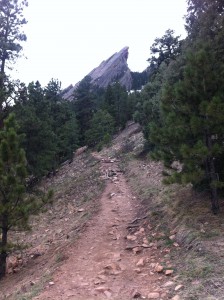 we moved here, is that we can get into the mountains from our front door. No driving necessary. Not only that, no parking necessary. On nice days and just about all summer long, you can’t park within a half mile of Chautauqua Park if you don’t get there at dawn. The area receives some millions of visits per year, more than Rocky Mountain National Park. Our house is about a 10 minute walk from the park, which is cool. We’re also about a 10 minute walk the opposite way from the west end of Pearl Street and about 10 minutes from The Hill and CU. We’ve saved millions of dollars in parking fees over the years, minus $25. The “minus $25” was for a CU parking ticket I got a couple of weeks ago. Go figure.
we moved here, is that we can get into the mountains from our front door. No driving necessary. Not only that, no parking necessary. On nice days and just about all summer long, you can’t park within a half mile of Chautauqua Park if you don’t get there at dawn. The area receives some millions of visits per year, more than Rocky Mountain National Park. Our house is about a 10 minute walk from the park, which is cool. We’re also about a 10 minute walk the opposite way from the west end of Pearl Street and about 10 minutes from The Hill and CU. We’ve saved millions of dollars in parking fees over the years, minus $25. The “minus $25” was for a CU parking ticket I got a couple of weeks ago. Go figure.
Anyway, on Saturday I hiked up to “The Third,” meaning the Third Flatiron. Actually, you can only get as far as the wildlife closure. They keep people, mainly climbers, away from the Third Feburary-July so that nesting raptors won’t be disturbed.
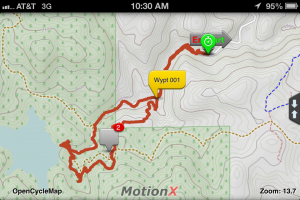 Sunday was different. The weather had turned ugly. What I mean by that is probably not what you think. It was clear and bright, no snow or rain. But the temperature was just above freezing and the wind had picked up. That combination of cold and wind makes hiking quite uncomfortable. Why? Because it’s really not cold enough to wear heavy clothing like you might do in the depths of winter, you get too hot from the work you’re doing. On the other hand, the wind really cuts any exposed skin so you need to cover everything to keep from freezing yet ventilate to keep from overheating. You end up in a constant battle of clothing adjustment. On top of that, when the wind gets that high it is just plain annoying!
Sunday was different. The weather had turned ugly. What I mean by that is probably not what you think. It was clear and bright, no snow or rain. But the temperature was just above freezing and the wind had picked up. That combination of cold and wind makes hiking quite uncomfortable. Why? Because it’s really not cold enough to wear heavy clothing like you might do in the depths of winter, you get too hot from the work you’re doing. On the other hand, the wind really cuts any exposed skin so you need to cover everything to keep from freezing yet ventilate to keep from overheating. You end up in a constant battle of clothing adjustment. On top of that, when the wind gets that high it is just plain annoying!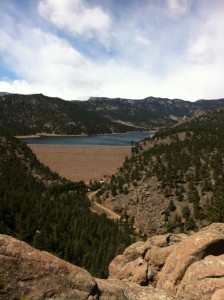
But I needed a workout so I went up to the Sleepy Lion trail just west of Lyons, CO, our old home town. It’s a fun, scenic loop that takes you into the forest for a view of Button Rock dam, right. GPS track is above left. You start out by walking down an access road for about a mile and then get into the forest trail. The trail takes you up and soon you get a view of the dam and reservoir below. On a perfectly clear day you can see Longs Peak in the distance, but not on Sunday. No, the wind was blowing over the divide, producing orographic snow and clouds to obscure the view.
The trail continues to the base of the dam and back out on the road you can see in the photo. I was surprised how popular this area had become and how many people were out on the trail even on this cold and windy day.
Another Tuesday, another foot of new snow at our house (see pic at the end)… Well, it measures slightly less than a foot but this is after consolidation overnight. Last week’s foot of new snow was very dry and powdery and completely melted away by the weekend. Yesterday’s snow was good and wet. If it doesn’t warm up really fast, and it’s looking like it might not, this snow could last a while. It seems to me the largest cause of our current drought is that it has been so warm in the spring. Last year it felt like we shifted from winter directly to mid-summer in March. The big spring runoffs happened more than a month early and the summer continued to be way too hot. This year is shaping up to be like a “normal” spring so far. We’ll see.
Posted in Journal by Mark with comments disabled.
Spring Snow in Boulder!
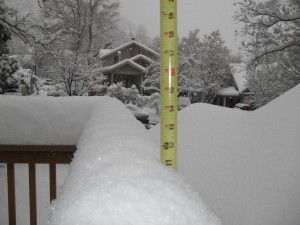 The spring snowstorm that started last night has left a foot of snow in western Boulder by 5 pm and it’s still snowing. Click on the picture to see proof!
The spring snowstorm that started last night has left a foot of snow in western Boulder by 5 pm and it’s still snowing. Click on the picture to see proof!
Posted in Journal by Mark with comments disabled.
Journal
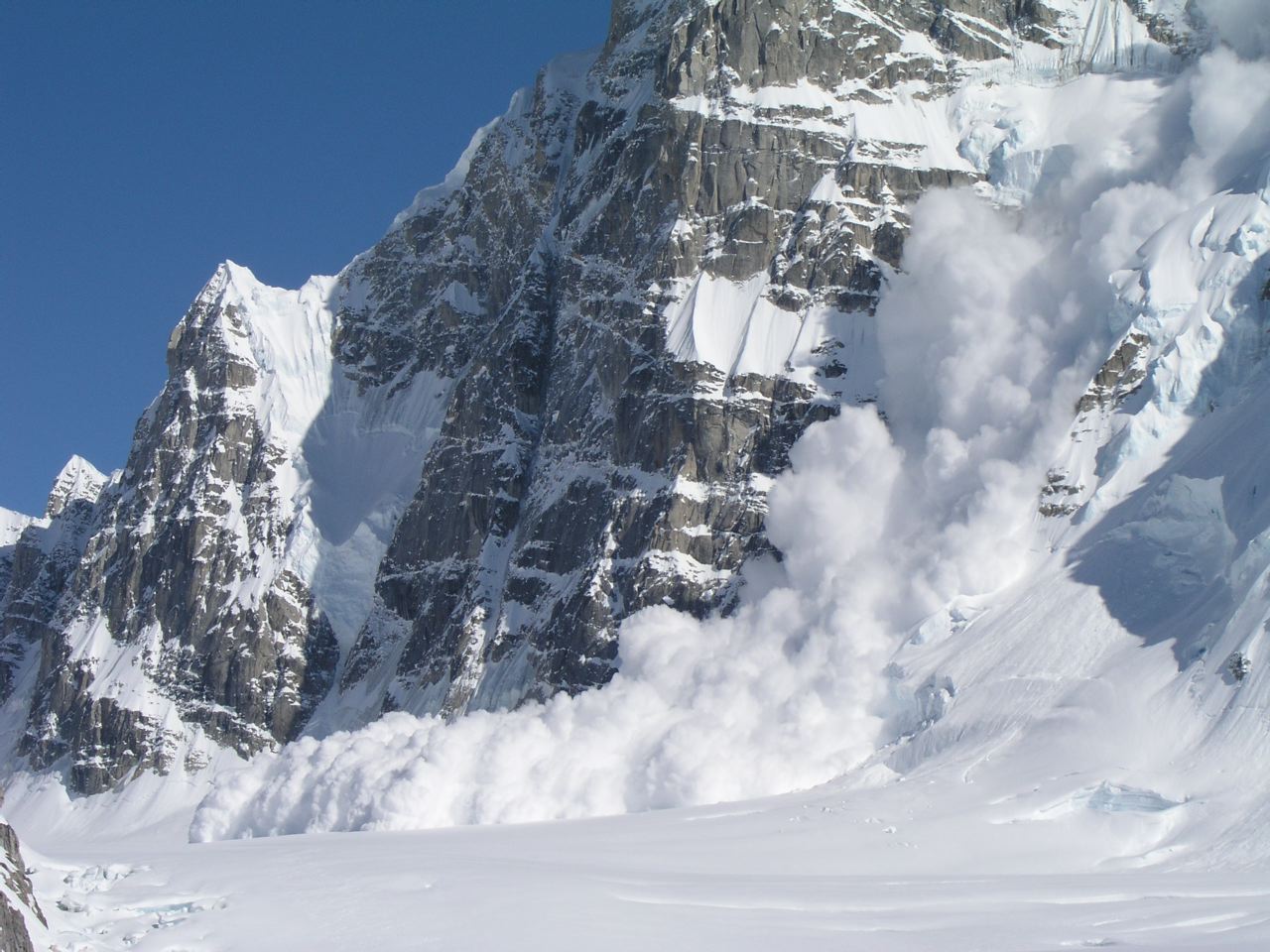
An Avalanche
Here is some of my bold yet exciting commentary about recent news items:
Avalanches: An avalanche survival story caught my attention recently. Alex White and Joe Philpott were backcountry skiing near Cameron Pass when they were caught and buried by an avalanche. Both were buried and Philpott did not survive. White, on the other hand, survived for over three hours before he was dug out by rescuers. This is nothing short of amazing. Avalanche victims are killed by either the trauma of the washing machine effect of an avalanche, or buy suffocation after burial or both.
While snow is flowing during an avalanche, it is like a powerful river flowing over boulders, cliffs and through trees, an irresistible force that carries victims like flotsam. When the flow stops, the snow “sets up like cement.” During the flow stage, the snow particles are almost in a state of liquid water that flows yet the overall temperature is below freezing. Once that snow stops, it’s like a pool of water that instantly freezes, solidifying more tightly than it had been prior to the avalanche. And like a frozen pool of water, almost all the air pockets in the snow are filled in. If your head is under the snow level when the snow stops, you are likely stuck in a solid tomb. Many victims are found with their mouths and noses filled with snow.
This isn’t always the case, though, which gives hope to victims and rescuers alike that survival is possible and searchers should continue until they find the victim. Surprisingly, there have been more than a few recent survival stories after long-term burial. Other strange things have happened in avalanches over the years, I wrote about one at Yankee Doodle lake, possibly the strangest avalanche in Colorado history, in Playing for Real.
By the way, the pic above is an avalanche on Mount Hunter in Alaska. On two of my trips there I witnessed big avalanches coming down this same chute, so large that the snow plume ran completely across the valley and covering our tent, a mile away, in a layer of snow dust. A spectacular force of nature.
Solo Survival: Never underestimate the power of the wilderness to make you suffer for your mistakes, or the strength of will to survive, or the consistency of human nature to produce endless stories of how these two interact. This story about Mary Owen who recently survived a week-long ordeal on Mount Hood in Oregon is one of the latest. Unlike the avalanche survival story above which was nothing short of amazing, this one is nothing short of predictable.
The inevitable story line is as follows:
- A plan is made to accomplish something.
- Events lead the plan astray.
- A chain of mistakes and bad decisions are made.
- Intense determination and single-mindedness blind the victim to all warning signs that things are going wrong.
- An accident happens.
- Great human suffering follows.
Then, either
A. The victim survives with at great story to tell, or
B. The victim dies.
This is the story told in The Endurance, Touching the Void, 127 Hours, etc. The great willpower that enables a victim to survive injury and starvation is the same willpower that blinded them to their mistakes in the first place. Of course, because this kind of story is captivating, I tell similar tales in Colorado 14er Disasters, where I try to put focus on the chain of mistakes being made. A great number of mountaineering disasters are not the result of a single bad event but rather a series of smaller events that add up to badness.
To me, the most interesting aspect of Mary Owen’s story is how she interprets her view of God in relation to her ordeal. It was understandably a life-changing event to her as it would be to anyone; to be injured, lost, and alone with the threat of death very near and then to be saved. But I don’t see anything miraculous. I don’t mean to single her out but the unfortunate thing for anyone caught in a mountain accident is that their story usually becomes public knowledge. This isn’t necessarily a bad thing and I am certain she will learn from her mistakes and maybe others will as well. She really did nothing that all dedicated climbers do at some point in their lives, and the good part is that she lived to tell her story. Which is…
…A strong-willed young climber determined to summit decides to solo a difficult mountain at a dangerous time of year. Ignoring or ignorant of easily available information about necessary and prudent equipment, she goes up alone without properly informing anyone about her plans. She gets lost in bad weather, not unusual for a person of this type of attitude. She is injured, which is not unusual for someone who is tired in difficult terrain, and survives several days in harsh conditions, which is difficult but again not unusual. She is missed at some point and a search team is dispatched to find her. And they find her.
Not a single aspect of her ordeal was unexpected.
Posted in Journal by Mark with comments disabled.
Journal
Taylor Glacier in Rocky Mountain National Park. Ski-able from the top!
I have to comment on this article about the “new” sport of uphill skiing. It’s a long article but in a nutshell it describes a growing trend of people who want access to groomed ski resort slopes and rather than ride the lift up, they climb under their own power and ski down.
How is this done? You buy specialized ski equipment called alpine touring gear, or AT gear. With normal downhill ski gear, your boots are securely locked flat onto your skis. With AT boots and bindings, you can release your heel while your toe remains attached. The hinge at the toe allows you to walk. You can then attach skins to the underside of your skis, a long sticky strip that grips your ski bottom on one side, and a felt side that has low forward friction and very high reverse friction, thus you can hike uphill and not slide backward.
We have been doing this for decades under the moniker ski mountaineering. However, mountaineering can be intimidating to many and so a new, safer activity was invented using the same techniques called uphill skiing. Uphill skiers want to avoid the inherent dangers of mountains. They want to avoid avalanches and the kind of spectacular accidents I wrote about in this article. But they do want to get outside for a fantastic workout that is not possible with downhill skiing.
The solution is to visit ski resorts where the environment is controlled and presumably safer, but not always, as this recent avalanche in Arapahoe Basin ski area proves. The skiers can attach skins to their skis, hike up the groomed ski slope to the top, remove the skins and get a great downhill run. They can’t get in as many downhill runs as the downhill skier, but the uphill skier gets the benefit of an aerobic workout.
This is exactly what ski mountaineers have been doing ever since skis were invented. But now we have a new, tamer version practiced in a resort. And this is the future, according to the companies that sell the equipment. Places like Steamboat saw the benefit and allow this activity on their slopes. Eldora, just above Boulder, does not.
Why is that? Eldora claims it is a safety/liability issue. Perhaps so, but liability hasn’t stopped many of the much larger resorts like Steamboat from allowing it.
I think the safety/liability excuse is disingenuous and the actual reason is because they won’t be able to charge for their expensive lift tickets. Eldora, being close to the super-fit, outdoor crazy Boulder population is likely to see much larger numbers of uphill’ers than other resorts.
I can all but guarantee that Eldora will allow uphill skiing at some point because they won’t be able to stop the poachers. What they should do, like other resorts, come up with a use fee, something like what they charge for the Nordic center. The only question is how much money they want to lose in the meantime.
———————————————————-
It’s ironic that Boulder, one of the major centers of the outdoor recreation universe, severely restricts activities that other areas encourage. The lack of uphill skiing in Eldora is one example. Ice climbing is another. I wrote about the impediments to ice climbing in Boulder Canyon several years ago, and nothing has changed since then except that the sport has grown much larger and many of those ice climbers live in Boulder. Ice climbing festivals are popping up all over, including Lake City, Cody, WY, and of course Ouray. Same can be said for bike racing. There are an unbelievable number of bike racers and fans in Boulder yet putting on an international race here causes major heartburn to the city bureaucracy. Other cities embrace these races.
Of course none of those restrictions deter anyone from living here. You’ll never see skiers, ice climbers and bikers abandoning Boulder.
———————————————————
My first posting this year mentioned that this may be the year of the comets. Well, one of them appeared a couple of weeks ago. It was very bright, easily visible to the naked eye. Unfortunately, most of Colorado was under cloud cover for many days and so most of us missed it. No worries, more to come.
Posted in Journal by Mark with comments disabled.
The Real World

Lisa Foster from the Estes Park News
I’ve always said:
“If you look at the victims of accidents in the mountains, they are evenly distributed between the novices and the experts. Neither the beginner nor the expert veteran are excluded from this law of nature.”
Well ok, maybe I haven’t always said that, and perhaps I’m paraphrasing, but this was the most important theme of Colorado 14er Disasters. Lisa Foster, pictured above, is most certainly one of the experts. She and David Laurienti were caught in an avalanche on Mount Ypsilon in Rocky Mountain National Park last weekend. Laurienti was killed while Foster survived but was injured and rescued.
Ypsilon is a popular climb in both summer and winter because it is relatively easy to access and has many routes ranging from easy hikes to technical rock to snow couliors (steep snow routes). Lisa Foster had extensive climbing experience all over Colorado and had climbed both Aconcagua and Denali. She had written one of the most popular hiking guides for Rocky Mountain National Park.
Yet she and Laurienti were caught in an avalanche, something that seems to be completely avoidable, especially by an expert mountaineer. Or was it? Reading this story while sitting comfortably at home with an unstressed (and inexperienced) mind, being lead along by a story that emphasizes, in hindsight, the stupid mistakes made, it could be easy to judge these people to be reckless or at least careless about climbing. But think again. No one, especially a mountaineer so viscerally in love with living, is intentionally so cavalier with their life.
Mountaineers are human of course and they do make mistakes. And just like everyone else, when distracted by exhaustion, thirst, hunger, cold, and the little aches and pains of high altitude winter climbing, mistakes can come more easily. I don’t know what happened on Ypsilon last weekend, but this happens to both the novice and expert.
Foster is most certainly a mountaineering expert. The media uses this word, usually without justification, to dramatize accidents. In Foster’s case there is vast evidence to prove it, a declaration from an ignorant reporter is superfluous. And so these things happen. So next time you hear about a mountaineering accident, remember that we are all human and accidents are part life. The only thing we choose is how we live.
Posted in Journal by Mark with comments disabled.
A long week
Well this has been a long work week and I wasn’t motivated enough to post anything earlier, but now it’s Friday!
Last weekend we were in town and planned on going Nordic skiing at Eldora on Sunday. But after breakfast it was just too spring-like in town to even consider going up to the cold snow and so we did a short hike on some trails just south of Eldorado Springs. It was a good choice, very low-key and uncrowded. This is in contrast with popular areas like Chatauqua or Mount Sanitas, where it would have been difficult to find a parking space on Sunday within a half mile of the traiheads. It was a beautiful day.
I had the day off on Monday and did end up going to Eldora to skate ski. The weather was terrible! It was about 15 degrees with high wind. Track conditions were better than last month but not by much. The tracks were icy and thin. I was able to get in a good hour of skating, though.
Here is another article about charging search and rescue victims to recover some of the costs for the operations. It is highly unlikely this will ever happen in Colorado due to the volunteer nature of rescue groups. This kind of story is reported in the media every so often anyway, probably because it generates strong feelings, mainly indignation from those who aren’t fully aware of all the issues. I’ll write some more about this subject in the future. There is a quote from a friend from RMR, Dan Lack (who is incorrectly identified as belonging to “Rocky Mountain Rescue Association,” a non-existent entity). Dan, by the way, is the crazy Australian who suggested the title Playing for Real for my book in 2006.
We finally got a significant snowfall in Boulder from an upslope storm this week. It dumped about 5 inches in town near the foothills. Kind of feels like winter again!
Posted in Journal by Mark with 1 comment.
Journal
Sunset over Rocky Mountain National Park yesterday
An update to Monday’s post, it looks like Troy Green, the man missing in Rocky Mountain National Park has been found.
The body was found yesterday by snowshoers in an area that “…had been searched several times by ground personnel, a dog team, and helicopter over-flights.” You may ask yourself how a couple of people simply out on a hike could find Troy when a large, coordinated mult-day search involving people, dogs and helicopters could not.
Well, the reasons are complex and this kind of thing happens more often than you would think. A major contributing factor is the vast size of the wilderness and all the obstructions it contains: A typical search might take place in a hundred square mile area of forests, boulders, cliffs and streams. If the subject is not in a high probability area such as a the trail or summit, and is unresponsive, it can be like searching for a needle in a haystack.
I write extensively about the reasons someone can seemingly vanish off the face of the earth in Colorado 14er Disasters, including the details of another extensive search in RMNP for a missing ranger named Jeff Christensen in 2005.
Posted in Journal by Mark with 1 comment.
Journal: Avalanche Hell Weekend

Winter Scene in RMNP by Wayne Boland
There was an impressive amount of reported avalanche activity last weekend here in Colorado, including several injuries and one death. I was out in the mountains but gladly avoided this hazard which I’ll talk about below. Instead, I spent the entire day Saturday in Rocky Mountain National Park snowshoeing near where someone went missing. We were in luck on Saturday as the weather was windy but otherwise crystal clear.
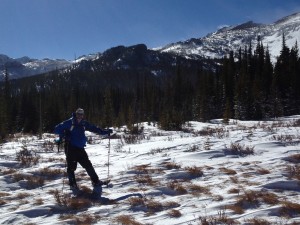 The prevailing wind in the Park is from the west or northwest. Check out the striations in the snow of the photo on the right showing the wind direction. This is an open meadow where the wind scours the ground leaving only a thin, hard-packed layer of snow for most of the season I would guess. This was relatively easy to walk on. However, most of the area is covered in a thick pine forest that catches and holds the wind-blown snow and in many places is 5 to 10 feet thick. Snow is usually not very consolidated this time of year, so walking in the forest even with “floatation,” meaning snowshoes or skis, is still quite difficult. You still sink into the deep snow about a foot or so and basically dig a trench as you break trail. If you have a group of people, the wise thing to do is trade off trail breaking duty often so no single person becomes exhausted.
The prevailing wind in the Park is from the west or northwest. Check out the striations in the snow of the photo on the right showing the wind direction. This is an open meadow where the wind scours the ground leaving only a thin, hard-packed layer of snow for most of the season I would guess. This was relatively easy to walk on. However, most of the area is covered in a thick pine forest that catches and holds the wind-blown snow and in many places is 5 to 10 feet thick. Snow is usually not very consolidated this time of year, so walking in the forest even with “floatation,” meaning snowshoes or skis, is still quite difficult. You still sink into the deep snow about a foot or so and basically dig a trench as you break trail. If you have a group of people, the wise thing to do is trade off trail breaking duty often so no single person becomes exhausted.
My original plan for last weekend was to do the Commando Run, a backcountry ski tour that runs from Vail Pass to Vail. This tour is great fun with beautiful views of the Gore and Sawatch mountains. We’ve done this trip many times, usually on Superbowl weekend to avoid the horrific traffic on I-70. If you’re interested, you can read more details about the Commando in The Insolent Guide. We cancelled this trip several weeks ago due to poor snow conditions and it turns out this was a good decision.
A recent storm on top of a relatively thin layer of existing snow has produced avalanche hell in Colorado. On Saturday a backcountry skier was killed near Silverton. A woman who was snowboarding in the backcountry triggered a massive avalanche near Berthoud Pass. SAR teams searched for possible victims but apparently no one was injured. For those unfamiliar with the Berthoud Pass area, it is a highly popular backcountry ski area where skiers can be dropped off near the top of the pass and ski down to the road below to be picked up later. The slopes are very steep and get wind loaded with snow, generating dangerous avalanche conditions quite often.
Another skier was hurt in a big avalanche near Cameron Pass west of Fort Collins. And apparently a lot of avalanche activity was reported near Steamboat Springs, including one near Buffalo Pass triggered by a skier. The Colorado Avalanche Information Center has issued an avalanche warning.
That was an exceptionally dangerous weekend for avi activity. Unfortunately, as the popularity of backcountry travel increases in Colorado, I would guess that the rate of avi accidents will increase even though they are largely avoidable with education and by paying attention to reports such as what the CAIC publishes. I hope I am wrong.
